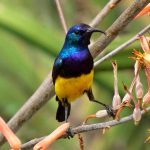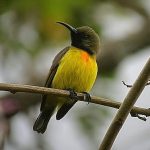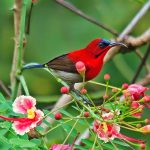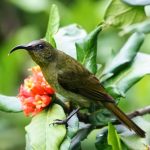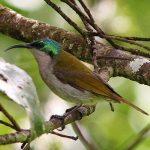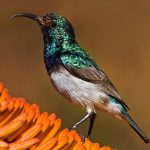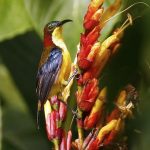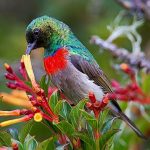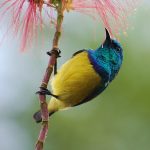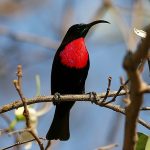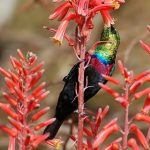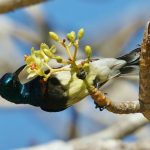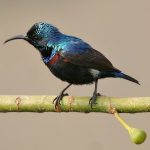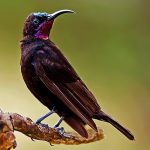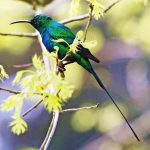Orange-breasted sunbird

Anthobaphes violacea
 |
| Photo by Chris Perkins (Internet Bird Collection) |
Common name:
orange-breasted sunbird (en); beija-flor-de-peito-laranja (pt); souïmanga orangé (fr); suimanga pechinaranja (es); goldbrust-nektarvogel (de)
Taxonomy:
Order Passeriformes
Family Nectarinidae
Range:
This species is endemic to South Africa, only being found in the fynbos biome of the Western and Eastern Cape regions.
Size:
Orange-breasted sunbirds are 12-15 cm long and weigh 9-10 g.
Habitat:
They are mostly found in fynbos habitats, generally preferring dense stands of Protea and Erica. They also occur in coastal scrublands and occasionally gardens, provided that there are enough nectar producing plants such as Aloe.
Diet:
Orange-breasted sunbirds mostly eat nectar of plants like Protea, Erica, Leonotis, Mimetes, Aloe, mountain dahlia Liparia spherica, pyjama bush Lobostemon fructicosus, cape-honeysuckle Tecoma capensis, wild lobelia Lobelia pinifolia, bugle lily Watsonia tabularis, Agapanthus and alien species like Hedera helix and Eucalyptus. They also complement their diet with invertebrates, including beetles, wasps, ants, bees, flies, crickets, locusts, grasshoppers, roaches, spiders and midges.
Breeding:
These birds breed can breed all year round, but tend to peak in April-September. They are monagomous and solitary nesters, with the nest being built solely by the female, consisting of a sturdy oval with a circular side entrance, built of dry twiglets, heather and soft plant material bound together with spider web. It is typically placed facing south or south-east, to avoid prevailing wind and rain, in a bush, scrub or tree, especially Protea and Erica. There the female lays 1-2 eggs which she incubates alone for 13-16 days. Both sexes feed the chicks which fledge 14-22 days after hatching, but continue to depend on their parents for another 3-4 weeks. Each pair may raise 2-3 broods per year.
Conservation:
IUCN status – LC (Least Concern)
This species has a relatively small breeding range, but is described as common. The population is suspected to be in decline owing to ongoing habitat destruction, but is not considered threatened at present.
